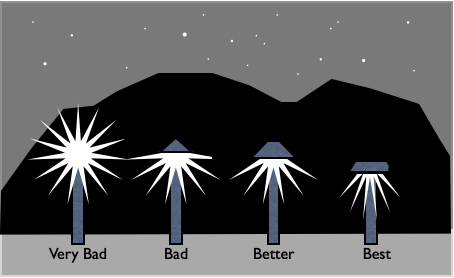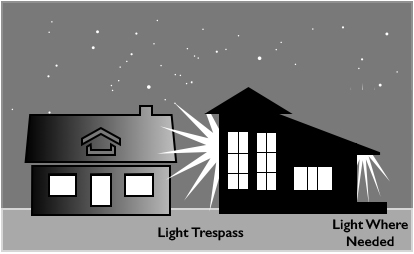By Galen Gisler and Didier Saumon, Jemez Mountains Night Sky Coalition
In previous articles, we have established that light pollution is undesirable on many fronts. Fortunately, light pollution is easy to prevent and reverse. Unlike many other sources of pollution and environmental degradation, individuals can make a difference with minimal cost and no change in their lifestyle to curb light pollution. What can we do about it?
We can advocate for better streetlights, shielded so as to illuminate the road and to avoid sending light into the sky or into people’s homes or eyes. We can talk to the businesses we frequent, to persuade them to use less lighting in their parking lots and to shield the lights on their facades. And, we can talk to our neighbors about good lighting practices.
But, to know what to say to our businesses and neighbors, we should start with our own homes, and therefore need to think about how good outdoor lighting differs from bad. We can start with the list of five principles of responsible outdoor lighting published by the International Dark-Sky Association:
- All light should have a clear purpose.
- Light should be directed only to where it is needed.
- Light should be no brighter than necessary.
- Light should be used only when it is useful.
- Use warmer color lights where possible.

What do we need outdoor lights for? To light a pathway to a door, to illuminate an area for outdoor dining or play, to show tripping hazards, for security, and so on. We also use light to show off features of our homes or to advertise our businesses. In some cases, reflective paint could serve in lieu of lights. Lights that don’t have a clear purpose should be turned off.
Importantly, light should not be gratuitously directed to where it is not needed. Light that shines directly in a person’s eyes is harmful, distracting, and unsafe. Light that shines into a neighbor’s yard or home is a form of trespass and is annoying, in the same way as an excessive noise disturbance. And light that is sent upward, a very common occurrence, is simply wasted. Some fixtures are designed with a well-controlled lighting pattern but they also need to be properly aimed.

A light shouldn’t be brighter than needed for its purpose. For a lamp above a doorway, 500 lumens (the equivalent of a 40 Watt incandescent bulb) should be sufficient. Why use more? Brighter is not always better, quite the contrary. Each particular installation will have its own requirements, and some trial and error may be necessary. But reducing illumination not only helps protect the night sky, but it also conserves energy, saves money, and is often far more pleasant.
When do we need light? At night, obviously, but there are very few instances where a light needs to be on all night. We can turn off our outdoor lights when we go to bed, or when our last guests have departed. By the same token, businesses can turn off outdoor lights, including parking lot lights, when they close up or as soon as practicable thereafter. Motion-sensor-activated lights are a good solution for brief tasks done outdoors, for unexpected guests, and for security but these need not remain lit for long. They should not be triggered by street traffic or small animals, and they must be aimed so they light only areas where directly needed.
The color of light is also important. Blue light is more strongly scattered in the atmosphere and in the eye than red. Consequently, lights that are bluer produce more glare, more skyglow, and more light trespass. We feel this instinctively: at night we prefer “warmer” light, like candles, fireplaces, and soft incandescents. We don’t put office-grade fluorescent tubes in our living rooms. At night, bluer light feels harsh and unpleasant.
But what about safety and crime, you might ask. There is in fact no evidence that more lighting leads to less crime. On the contrary, over-lighting leads to dark shadows in which crime can occur unseen. For security purposes, lights activated by motion detectors and infrared sensors are much more effective means of crime prevention and detection, and lead to much less light pollution.
